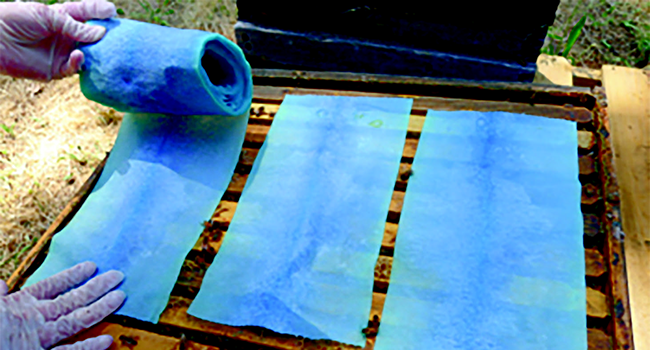By: Jennifer Berry
Use Methods For Controlling Varroa That Are Tested, Legal and Work
Last year, a new method of using oxalic acid (OA) was publicized by Randy Oliver, Scientific Beekeeper. According to his updates, he was having pretty good results with the new method. Beekeepers, along with myself, became hopeful that this new formulation would be the silver bullet we’ve all been waiting for. Not only did it look promising in controlling mites, but it was easy to mix, apparently had no adverse side effects to bees, brood or queens, had no wax or honey contamination issues and finally, it was cheap. It consists of mixing OA crystals with food grade vegetable glycerin, applying the mixture to a delivery matrix (shop towels or cardboard strips) and then placing the material in the hive. After just a few short months, it quickly became a popular method for treating mites. Because of its popularity and wide spread use among beekeepers, it drew the attention of the EPA and USDA, along with myself.
At that time, this method had only been tested on the west coast, where it is hot and dry. We needed to test whether this method would work in a hot and humid environment as well. Plus, we needed a large-scale study that included multiple apiaries. So, I contacted Randy, and after numerous phone calls, and emails between a gaggle of folks, an experimental design was formulated to a) test the efficacy of the new method, b) was it detrimental to bees/brood/queens, and c) was OA being absorbed into honey. Once we were all in agreement, it was time to get to work. The UGA Bee Lab crew, along with the Auburn University Bee Lab folks, traveled to South and North Georgia collecting data for days at a time. All total, 17 people were involved setting up the experiment, collecting and analyzing the data.
In October 2017, I published an article briefly discussing the study but at that time, we had not completed analyzing the data. We were still hopeful we could have results within a few months but unfortunately, we were a bit too optimistic. The data set was very large and took us much longer to analyze than we had anticipated. Before we get to the results, here’s a recap of the project.
The study: With the number of colonies involved, we asked two commercial beekeepers, Shearer Turton, (Dream Haven Farms), and Bob Binnie, (Blue Ridge Honey Company), if they would be willing to donate the use of their colonies and help us collect data for the study. Thankfully, they both agreed, since our UGA colonies were already involved in one study or another.
The protocol: For our Southern trial, there were four treatment groups, each with 50 colonies/group. Two of the groups received the delivery matrix (shop towels) (Photo1) with the OA mixture at different concentrations; one with 12g and the other with 18g. The towels were applied to the top bars inside the brood chamber. The other two groups were the controls; one with shop towels and glycerin only and the other with nothing at all.
It took 10 people three days to number, weigh, calculate bee & brood amounts (colony assessments), collect 300 bees in alcohol and apply the shop towels in all of the 200 colonies. Doing colony assessments gives us beginning bees and brood populations. This will test to see if the treatment has any detrimental effects on the bees. The 300 bees collected in alcohol gives us beginning mite numbers (to test if the product is actually working). Twenty four days later in July we traveled back down to Cordele and collected the same data as before, along with % of the towels removed. This gave us ending data for comparison. We were encouraged to see numerous dead mites scattered about on the folds of the paper towels.
The next month we headed North to Lakemont Georgia and repeated the same process of data collection.
Results: Even though these results are still preliminary, we do not recommend using this method for reducing mite populations in honey bee colonies. Why? Because the data didn’t show any significant decrease in mite levels in the 12g or 18g extended release method. The reason I am saying “preliminary” results is we are going to repeat the study. Actually, we will start in early July, and plans are to alter the study protocol just slightly. My fear is (which has been substantiated through personal conversations, and emails) there are numerous beekeepers out there using this unapproved, illegal method of applying OA. Some say it is working, some say it’s not, some say it isn’t harmful to the bees, some say it is. That is why we need to continue to examine, experimentally, with numerous colonies, in different regions, to see whether or not this method works. Otherwise, potentially lots of bees will succumb to mites, lots of beekeepers will be out of money and lots of folks will be unhappy.
Even though this new manner of applying OA may seem to be easier and cheaper, if it doesn’t work, then what’s the point? We do know that the three approved methods of applying OA significantly kills mites, and does not harm bees or humans if applied according to directions. Even though I’ve written about this before, I would like to revisit it again. The three methods approved for use in honey bee colonies are trickle (dribble), vaporization (sublimation) and spraying (spraying). All three can be used on existing colonies, packages or swarms. The two most popular methods are the trickle and vaporization method. The trickle method is prepared by mixing the OA with a sugar water solution and then trickling the solution down between each frame (seam), directly onto the bees when temperatures are between 35-50°. The bees must be in a tight cluster in order to distribute the OA from bee to bee. Any mite coming in contact with the solution, will perish. The second is to heat the OA until it vaporizes into a gas (sublime). This is accomplished by placing the OA crystals into the plate, and then connecting the metal wand or vaporizer to an electrical source. The plate heats up, melting and vaporizing the acid. The vapor will permeate the hive and when it comes in contact with the mites, kills them. Yeah!!! The method that we prefer is the sublimation method. It takes a bit more time to use the wand than to trickle, however, it’s not as hard on the bees and it works better.
You can also spray (mist) packages or swarms with the same mixture of OA and sugar syrup used for the trickle method, but we don’t recommend this method because it is very hard on the bees. Why? Because you have to hold them in a cool, dark location for 24 hours prior to spraying. Once tightly clustered, the bees must be sprayed with sugar syrup several hours prior to applying the OA, to ensure that their honey stomachs will be full. Otherwise, they will ingest the OA sugar syrup mixture, which can cause harm or worse, kill the bees. After spraying with the OA mixture, you must hold the bees for an additional 72 hours. If you want to remove mites from your packages, there is a much easier and less harmful method. Once you install the package, wait a few days, and vaporize after sundown. Caution, make sure you don’t wait too long because you don’t want any capped brood present. Why don’t we want capped brood?
All three of these methods (or any method for that matter) are most effective if they kill at least 90% of the mites in the colony. Otherwise, mites and more importantly, viruses (which are the real culprit) will continue to reproduce and overwhelm the colony. This can only be achieved if the colony is void of capped brood and the mites are phoretic (crawling around on the frames or adult bees). If there is capped brood, then, the majority of mites are under the protective wax capping and will not be exposed to the OA. This is why applications are most effective when no brood is present.
During the Winter months, queens usually “shut down” or at least have slowed down brood production. This natural brood break is an easy opportunity for us to decrease mite loads, so we don’t want to miss our chance. But wait! What about now, today, this Summer, when mite populations are on the rise (compromising the health of our colonies), yet colonies are full of brood? Reducing mite populations will only help our girls going into Winter. Bees weakened by viruses enhanced by the mites will not live as long. Bees produced to survive the Winter (Winter bees) need to live longer than the Summer bees, so by reducing mites & virus loads now, it’s gives our girls a fighting chance for Winter survival.
Over the years, I’ve discussed a way to make a colony broodless by simply caging the queen. Well, caging a queen is not that simple, so after serious thought, much pondering and contemplation, I’ve come up with a better, simplified method of getting a colony free of capped brood. Ok, actually it wasn’t completely my idea; Jay Hendrix, Master Beekeeper here in the state of Georgia, emailed me, asking a question that has proven to be a great solution. His question was; why not just exclude the queen in a super for 14 days, and then treat on day 21? Brilliant! Of course! Here’s the plan of action to rid our girls of these nasty parasites & viruses during the brood rearing season.
- Find the queen and exclude her in a super above the brood nest.
- In the super with the queen, place one or two frames of drawn comb for her to lay in and fill the rest with honey or pollen frames, or frames with just foundation. By giving her frames that are undrawn or already filled with honey or pollen, it will inhibit her ability to lay a ton of eggs.
- 14 days later, remove the excluder, releasing the queen.
- Check for queen cells below the excluder just in case the bees have produced any.
- Remove frames above the excluder which contain brood and – see below
- 21 days after excluding the queen (seven days after removing the excluder), vaporize colonies with OA at sundown when all the bees (and mites) are home from their foraging trips.
What to do with the brood frames that the queen was allowed to lay in for the 14 days, the ones above the queen excluder? If you only have one or two colonies, or you don’t want anymore colonies, you can sacrifice the brood by freezing the frames. Or, you can take those frames with brood and bees and make a “walk away” split. You can either place a queen cell in this split or allow the bees to raise their own queen, then 21 days after you made the split and all the brood has emerged, you can vaporize with OA.
Some may still question why 14 days, 21 days, etc.? It takes 21 days from egg to an emerging adult worker bee and it takes eight days from egg to capped brood. By breaking the brood cycle, we are able to take advantage of the time between when the egg is laid and the brood is sealed under the protective wax cap. The mite enters the cell just prior to the larvae being capped, so we need to catch the mite BEFORE she enters the cells to reproduce. This is why we treat when there is no capped brood, so all the mites will be exposed to the acid. By shutting down the queen for 14 days, there will be no capped brood on day 21 when we treat with OA, however, there will be capped brood soon afterwards, so make sure to count the days properly.
In our area, the Piedmont region of Georgia, the best time to use OA is during the cold winter months (January) when hopefully the queen has “shut down” and there is little to no brood. The next time would be during the summer months when we “shut down” the queen and force a brood break. We can also take advantage when we requeen a colony or when a colony has swarmed. Quick reminder, when using OA, all “human” consumable honey must be removed from the colony. Usually by the end of July most honey flows have ceased in our region of Georgia.
Recently, I was asked to speak to one of our local Georgia bee associations and the topic they chose was “when searching the Internet, how do we know if the information is correct or not”. At first I thought, “what a great subject”, but as I researched it further, I realized this was not going to be an easy task. First off, there is a ton of information out there concerning bees, plus, as I narrowed my search to just videos, I came across a pile of them that were flat out WRONG, not to mention illegal. Bad information was more wide spread than I first thought. For instance, I typed in, “how to control Varroa” and focused on the top ten video hits. Out of those, only one, ONE was legal, has been tested and we know works. That was using oxalic acid in a vaporizer.
I’m sure you have heard the saying “the label is the law.” Well it is, and as silly as it may seem at times, that label, the one found on a can, jar, container, or bag is there for a reason. In the case of beekeeping it is there to protect you, the bees, and the environment, so please, use what has been tested, what is legal and what works. There are plenty of proven options out there that work so we don’t have to reinvent the wheel, take a chance with our health or the health of the bees. Mother Nature will thank you.
Take good care of you and your bees.
Jennifer Berry is the Research Leader at the University of Georgia Bee Lab in Athens.








